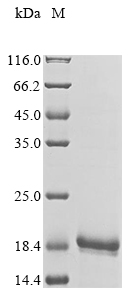The region for expressing recombinant Human VSTM5 contains amino acids 29-147. This VSTM5 protein is theoretically predicted to have a molecular weight of 19.3 kDa. The VSTM5 protein was expressed in e.coli. The VSTM5 gene fragment has been modified by fusing the N-terminal 10xHis tag, providing convenience in detecting and purifying the recombinant VSTM5 protein during the following stages.
V-set and transmembrane domain-containing protein 5 (VSTM5) is a cell-adhesion-like molecule belonging to the immunoglobulin (Ig) superfamily. Studies have found that VSTM5 is an N-glycosylated membrane protein highly expressed in the central nervous system (CNS). It promoted the development of neuronal dendrites and protrusions, such as dendritic filopodia. During synaptogenesis, VSTM5 modulates synapse formation by modifying dendritic spine morphology and the distribution of actin. VSTM5 plays a role in regulating neuronal morphogenesis and migration during cortical development in the mouse brain. These findings suggest that VSTM5 could be a new membrane protein directly modulating membrane dynamics for neuronal morphogenesis and migration, potentially influencing neural circuits and brain functions.






